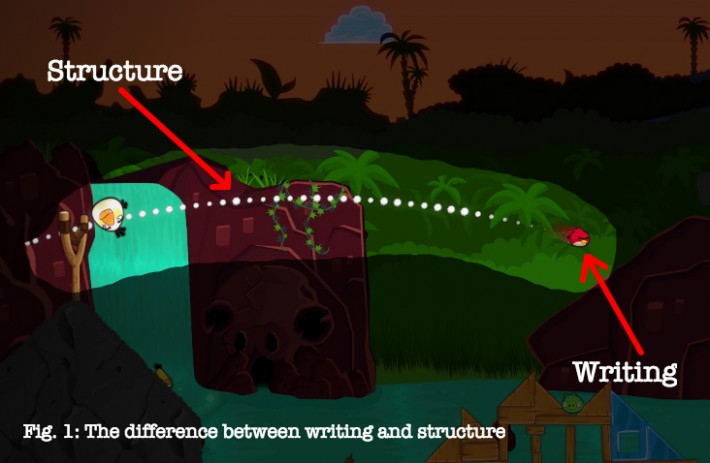I’ve started to become a bit of a structure nut.
For the longest time I held a strong beatnik opinion that great writing doesn’t come with pre-planned structure. “It just flows, man.” Like most of the cynics I know and love I resented the formulaic nature of popular TV, romantic comedies and films directed by Michael Bay.
I celebrated the spontaneous genius of Hunter S. Thompson and resented the predictable formula of those sitcoms about burned out actors and their quirky fucking families.
I related with Charlie Kaufman’s anguish in Adaptation and hoped beyond hope he could make a great film that didn’t have the three-act structure, sex, drugs and violence in it.
But more than anything else, I thought I could write everything I wrote using sheer momentum – ploughing through and finding the right rhythm along the way.
Idiot.
Until very recently, I didn’t actually know how to write an outline. I write outlines because that’s how things work in an agency, but I always end up with a word count that’s unnervingly close to that of the final piece.
I really wanted to know how to think at an altitude a couple of levels higher than the actual words I was writing. But at the same time I wanted to be the kind of maverick genius that just figured that shit out on the fly. What I didn’t understand, was that those two things are almost polar opposites.
Outline thinking is about calmly plotting the arc and trajectory. Doug compares it to the shape of the curve you make when you fire an angry bird. Writing on the other hand (for me anyway) isn’t nearly as calm or methodical. To me, writing is the art of becoming the angry bird.
That’s why it feels more like barreling through a series of brick walls with your head down. It’s way more fun but also way more reckless with the reader/viewer/listener’s attention. You’re making the rhythm up as you go along.
You can do that for thirty seconds, a minute, even five at a push. But at some point, you’re going to succumb to the basic principles of entropy. They’ll lose interest or you’ll lose focus. Either way, there’s little incentive to find out what’s coming next.
The longer the form the more important the structure
A few weeks ago I took a scriptwriting course and confronted the three-act structure in all it’s deliberate glory. A part of me felt like I would come out of that session convinced I could break all the conventions I’d learn. “If you know the rules, it’s easier to break them,” I thought.
Instead I came out more convinced than ever before, that structure is critical to great content. It may not be the essence of great content. But it’s the bottle that holds it together. And the longer the form of the content, the more useful the structure tends to be.
It’s useful to the writer/creator because it saves you from running out of steam and losing control of the piece. And it’s useful to the viewer/reader/listener because they’re reassured that someone’s thought this journey through.
It’s kind of like the cables on a cable car. The passengers are safe in the knowledge that they can look down and get lost in the scenery below them. All the while the cables give them the pace and direction they need (*cough* velocity *cough*) to enjoy the wilderness below without getting bored (or acknowledging the fact that they’re basically dangling in a tin box hundreds of feet above the ground.)
Invisible hands are creepy…but helpful
Like I said, I’m one of those cynical bastards who’ve always resented the fact that Michael Bay films and Matthew McConnaughey romantic comedies are so popular. It gutted me that elements like character, plot and story are seemingly interchangeable so long as the good guy wins in the end.
What I’ve come to appreciate is that the structure in those films is comforting. It’s like an invisible helping hand the audience doesn’t want to acknowledge exists for the duration of the film, but would deeply resent the lack of. This is true of films, songs, podcasts and eBooks.
It’s why I’m becoming increasingly convinced that a lack of structure is the number one killer of content quality. You can have a great idea, a great tone of voice and loads and loads of winks. But without clear, navigable structure to guide your audience, those winks are just going to look like a twitch, and no one’s going to want to follow your brilliant idea to its insipid conclusion.
—
The funny thing is, as much as I celebrated the spontaneous genius of Hunter S. Thompson, I didn’t realize he spent his days as a young writer transcribing whole books by Hemingway in a deliberate attempt to experience the feeling of writing with complete command of the reader’s attention.
And I didn’t appreciate that without all the sex, drugs and violence in the third act of Adaptation, I wouldn’t know and presumably care about Charlie Kaufman’s anguish.
And I certainly didn’t expect to find myself spending the better part of a month struggling to find the right structure for a blog post about structure.
—
(Photo credit: Michele M. F.)

Enjoyed this article?
Take part in the discussion









Comments
Fiona Campbell-Howes September 30th, 2014
Hi Harry, I enjoyed this post very much – not least because I have the same problem as you do (or you did), in that my outlines always end up being rough drafts of the final piece. If you felt like doing a follow-up post on how to write a proper outline, I’d be all ears 🙂
Harendra Kapur October 2nd, 2014
Fiona! Funny story. So after I take the scriptwriting course, I’m looking for the three act structure in everything we do. And then one day it clicks. I realise our slideshares and videos DO have a three act structure and there is a level of formula to them. So I draw the little diagram and go running to Doug, giddy at the thought that there is a mystical structure we follow. He sees the structure and says it’s great. He says it’s definitely something we follow, even if we do so subconsciously. He says write the post.
So I do my standard google search to see if anyone else has written about the thing I’m about to. And I find this post about content marketing and the three act structure. And it’s brilliant. And personal – the writer’s clearly a content marketer, but she’s also dating a screenwriter. So first i get excited that someone else is thinking this way.
But then I get totally bummed that a far better writer than me has already written about the three act structure in content marketing.
And then I see her first example. It’s a video. And it’s written by Doug Fucking Kessler.
So I scroll up to see who’s written this beast of a post.
And it was you.
(PS. I’ll be attempting a ‘how to outline’ type thing soon – just have to figure out how to outline first…)
Fiona Campbell-Howes October 9th, 2014
Hi Harry, sorry for very late reply! Glad you liked the post; we’ve had James in a couple of times to train our writers in using a three-act structure (also the seven basic plots etc.) and both times we’ve used Doug’s ShipServ Pages video as an example. I love that video. I think we probably all do use three acts subconsciously as it’s the fundamental shape of what we consider a story. The skill comes in creating conflict, tension, and emotional highs and lows rather than just describing a list of things that happen. All good stuff. Looking forward to the ‘how to outline’ post!
Kristen Hicks December 1st, 2014
Good points! I also spent much of my life insisting I worked better without an outline. It’s easier to just sit down and write and figure out my thoughts through the process of writing.
Writing professionally though, I’ve learned that the writing is much more efficient and easier to organize into web-friendly formats if I create even a basic outline while I’m in the research phase. It doesn’t have to mean the work becomes more formulaic, just that you have an idea of what you’re going to say and how all the ideas you’re expressing connect to one another before getting the full piece onto paper (or computer screen, rather).
Network Cabling November 27th, 2024
This post makes a compelling case for the importance of structure in creating effective content. It emphasizes that even the most creative ideas need a solid framework to engage and guide the audience. While spontaneity can spark creativity, a clear structure ensures that the message resonates and is easy to follow. This insight is especially useful for those in content creation who may undervalue planning ahead. A thoughtful reminder that great content is often as much about how you organize your ideas as it is about the ideas themselves.